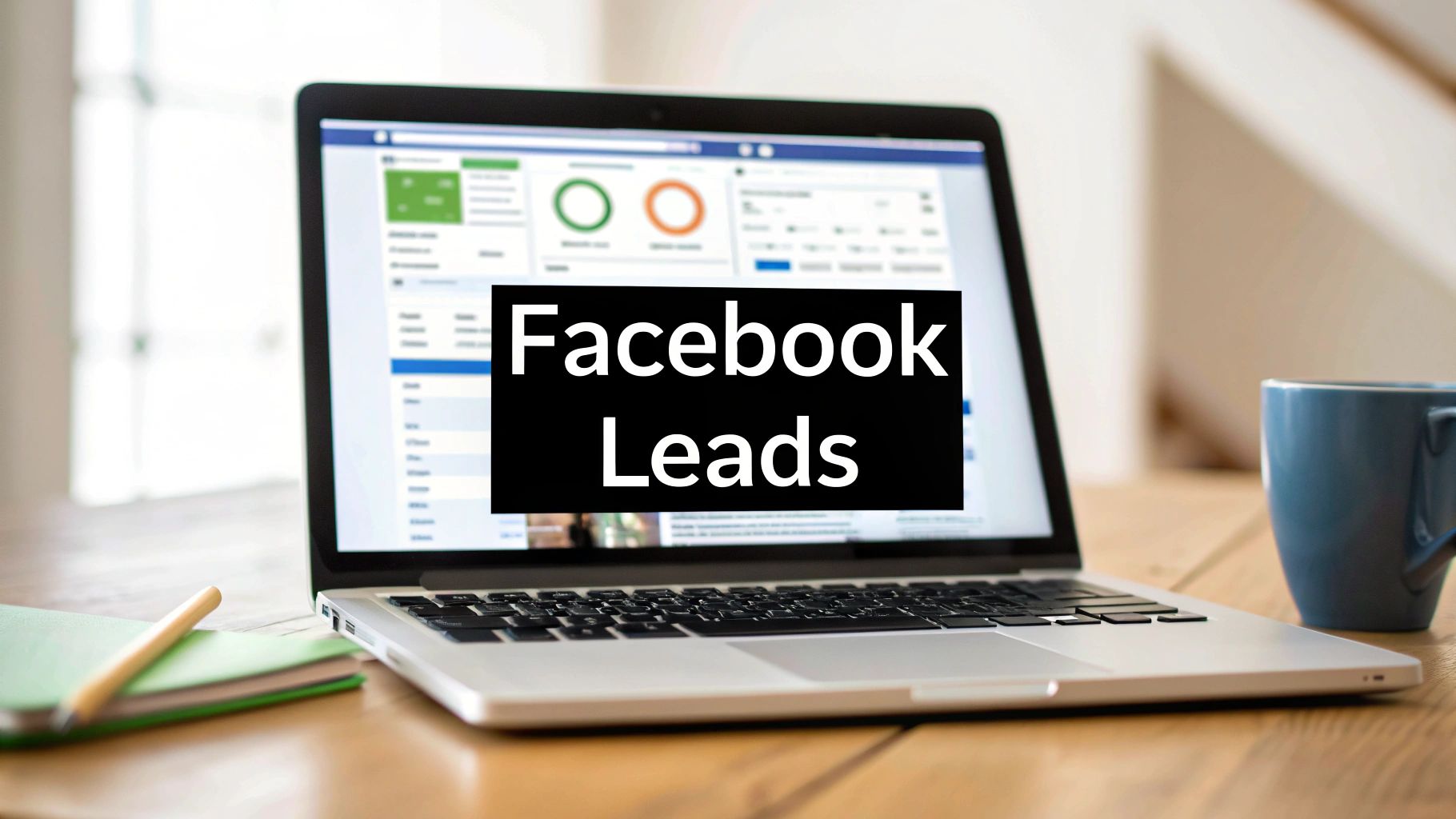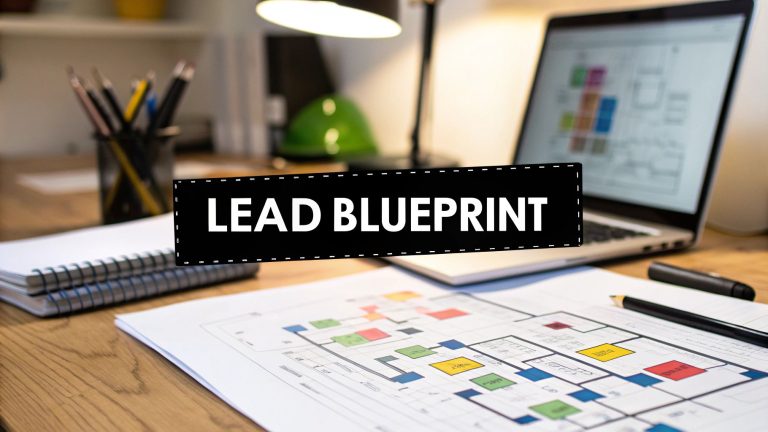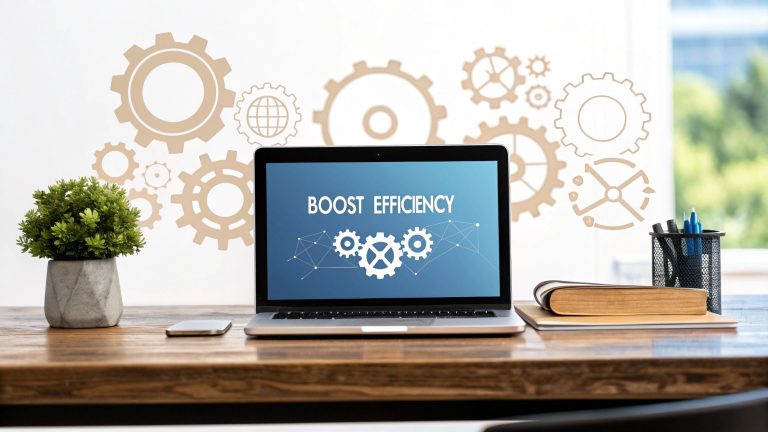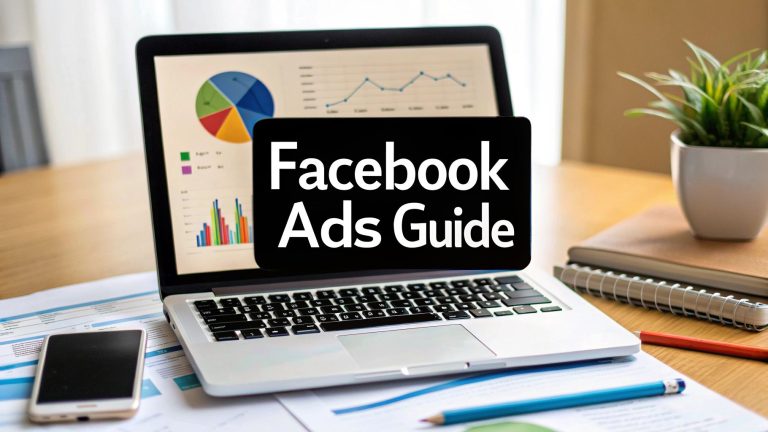Generate Leads With Facebook A Practical Guide
If you're looking to generate leads on Facebook, you need to think beyond simply boosting posts. The real magic happens when you use dedicated ad formats like Facebook Lead Ads. These ads are a game-changer because they feature pre-filled forms that grab a user's information right on the platform. This slashes the friction and makes it incredibly easy for people to sign up, turning passive scrolling into a genuine lead capture moment.
Why Facebook Is a Lead Generation Powerhouse
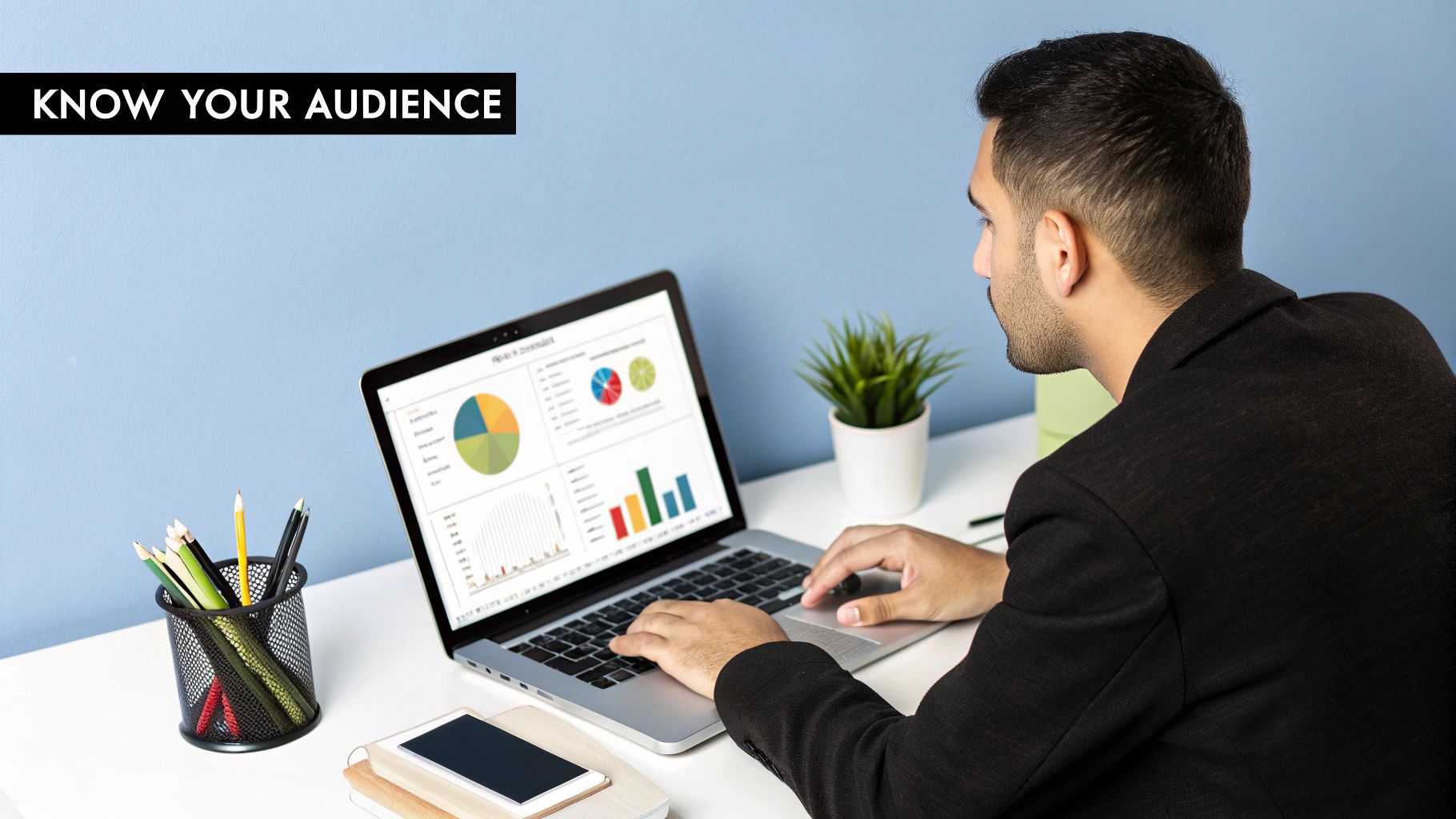
With all the shiny new social media apps popping up, it's fair to ask if Facebook still has what it takes for serious business growth. The answer is a resounding yes. While other platforms are great for chasing trends, Facebook has quietly become an incredibly powerful machine for connecting businesses with their ideal customers. It's not just for sharing family photos anymore; it’s a strategic tool for predictable business growth.
The sheer number of users is one thing, but the real power is in the data. Facebook's advertising tools let you pinpoint your ideal customer with astonishing accuracy. Forget broad demographics—you can target users based on their specific interests, what they do online, major life events, and even how they've interacted with your business outside of Facebook. This means every dollar you spend is going toward reaching people who are actually likely to be interested in what you're offering.
Unpacking The Numbers
The proof isn't just in the pudding; it's in the numbers. Facebook is still a dominant force for businesses all over the world. The platform's massive user base and advertising tools create a potent mix for lead generation.
Here's a quick look at why Facebook is such a compelling choice for businesses aiming to grow.
Facebook's Lead Generation Potential at a Glance
| Metric | Statistic | Business Implication |
|---|---|---|
| Monthly Active Users | Over 3 billion | Your potential audience is massive, offering unparalleled reach. |
| Business Usage | 91% of businesses use it | Your competitors are likely here, making it essential to have a strong presence. |
| Avg. Ad Conversion Rate | Around 9.21% | When done right, Facebook Ads offer a highly profitable channel for new customers. |
These figures aren't just abstract data points. They represent real opportunities. People often browse Facebook during their downtime, making them more open to discovering a solution to a problem or an offer that genuinely adds value. When your ad pops up in their feed, it feels less like a jarring interruption and more like a helpful suggestion.
Ad Formats Built For Action
Facebook knows its value to advertisers depends on delivering real, measurable results. That’s exactly why they’ve developed ad formats specifically designed for lead generation.
Here’s what makes them so effective:
- Instant Forms: This is the cornerstone of capturing leads on Facebook. These native forms can be pre-filled with a user's profile info (like their name and email), which means they barely have to lift a finger to sign up.
- Reduced Friction: The entire process happens inside the Facebook app. By not forcing users to click away to an external landing page, you can see a huge boost in your form submission rates. It’s that simple.
- Mobile-First Design: The vast majority of people use Facebook on their phones. These forms are perfectly optimized for small screens, guaranteeing a smooth and easy experience for every user.
The core of what is lead generation in marketing is all about connecting with people who are already interested. Facebook just makes it easier by letting you meet them right where they are, removing the barriers and encouraging them to take action immediately.
When you generate leads with Facebook, you're tapping into a proven ecosystem. It’s a powerful formula that combines massive reach, pinpoint targeting, and tools built to convert. For any business looking to grow its customer base, Facebook provides a direct line to your audience, turning a passive 'like' into a high-quality, actionable lead.
Alright, time to get our hands dirty. You know why Facebook Lead Ads are a goldmine, but that's just theory. Now, we’re stepping into the Ads Manager to build a campaign that actually works, from the ground up. Forget the confusing jargon; this is all about practical steps that get real results.
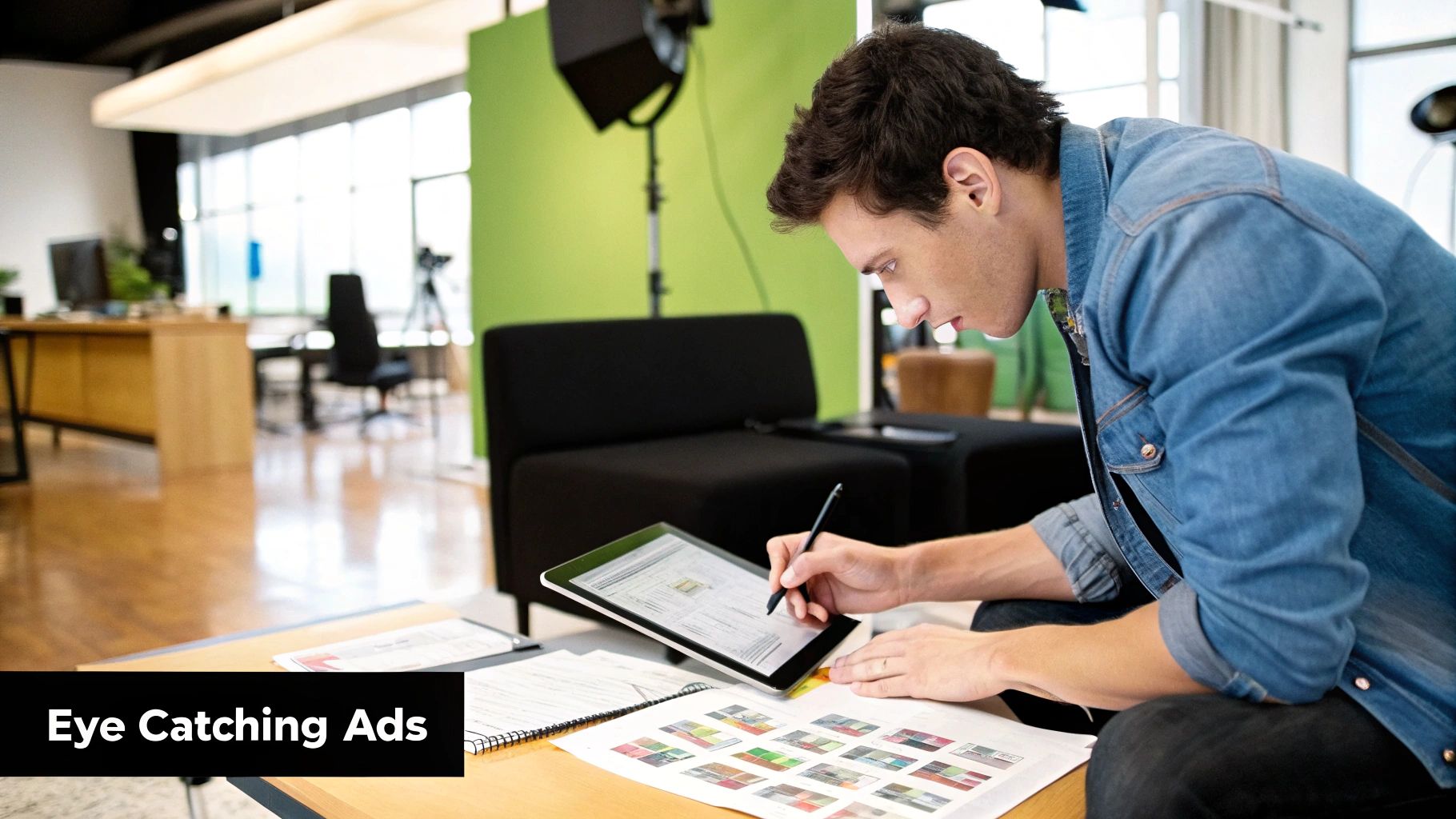
Your journey begins by laying the right foundation. When you start a new campaign, Facebook will ask you for your campaign objective. For what we're doing, the choice is simple: you have to select 'Leads'.
This one click tells Facebook's powerful algorithm exactly what you want—to gather info from potential customers. It's a critical first step because choosing 'Leads' unlocks the specific tools we need, like the all-important Instant Form.
Defining Your Ideal Customer
You could have the most amazing offer in the world, but if you show it to the wrong people, it will always fall flat. This is why audience targeting is the most critical part of building a successful campaign to generate leads with Facebook. The platform's real power is its ability to go way beyond basic demographics.
Instead of just targeting by age and location, you can craft a super-specific audience profile based on a mix of factors. Really think about the people you want to reach. What are their interests? What brands do they already love and follow? What are their recent life events or even their purchasing habits?
A local real estate agent, for example, shouldn't just target people aged 30-55 in their city. They should be targeting users who’ve shown interest in Zillow or Realtor.com, recently interacted with mortgage calculators, or are even tagged with behaviors like 'likely to move'. This laser focus ensures your ad budget is spent only on those most likely to convert.
Pro Tip: Don’t be afraid to get granular. A smaller, highly relevant audience will almost always outperform a large, generic one. It’s far better to have 10,000 people who are genuinely interested see your ad than 100,000 who couldn’t care less.
Start with what you know about your best customers and build out from there. This data-driven approach is what separates campaigns that thrive from those that just get by.
Crafting Ad Copy and Visuals That Convert
In a crowded news feed, you have just a few seconds to grab someone's attention. Your visual—whether it's an image or a video—is the first thing people notice, so it absolutely has to be a "scroll-stopper."
-
Images: Use high-quality, vibrant photos that clearly show your product or the result of your service. Ditch the generic stock photos. Real faces and authentic-looking scenarios almost always perform better.
-
Videos: Short-form video is king right now. A 15-30 second clip can explain your offer and show its value in a way a static image just can't. To really get the most out of your lead ads, understanding the details of how to optimize for conversions is key, especially when it comes to Facebook video conversion strategies.
Once your visual hooks them, your ad copy has to reel them in. Keep your text clear, concise, and focused on the benefits. Don’t just list features; explain how your offer actually solves a problem or makes the user’s life better.
A great structure to follow is:
- The Hook: Start with a question or a bold statement.
- The Problem: Briefly touch on a pain point your audience has.
- The Solution: Introduce your offer as the perfect fix.
- The Call-to-Action (CTA): Tell them exactly what to do next ("Click to download your free guide!").
Designing The Perfect Instant Form
This is the final, and maybe most important, piece of the puzzle. The Instant Form is where the magic happens and you capture the lead. The best part? These forms are pre-filled with the user's Facebook profile info, which slashes the friction and makes it incredibly easy for them to submit.
When you build your form, you'll configure a few key sections:
-
Form Type: You can choose between 'More Volume' and 'Higher Intent'. 'More Volume' is great for getting as many leads as possible. 'Higher Intent' adds a review step for the user, which can improve lead quality but might lower your submission count. For most campaigns, 'More Volume' is the best place to start.
-
Intro: This optional section is perfect for restating your offer and its benefits. Use it to remind them why they should give you their information.
-
Questions: This is critical. Only ask for the information you absolutely need. In most cases, Name and Email are enough. Every extra field you add will cause some people to drop off. If you need more, try to use multiple-choice questions to keep it simple.
-
Privacy Policy: You must include a link to your website’s privacy policy. This is a non-negotiable requirement from Facebook.
-
Completion Screen: This is your "Thank You" page. Don't waste this space! Use it to set expectations ("We'll be in touch within 24 hours!") and give a clear next step, like a button to visit your site or download the resource you promised.
By thoughtfully designing every element—from the campaign objective to the final click on the form—you create a seamless path for the user. This streamlined process is designed to turn a passive scroller into a qualified prospect, making Facebook a true lead generation engine for your business.
Focusing on Lead Quality, Not Just Quantity
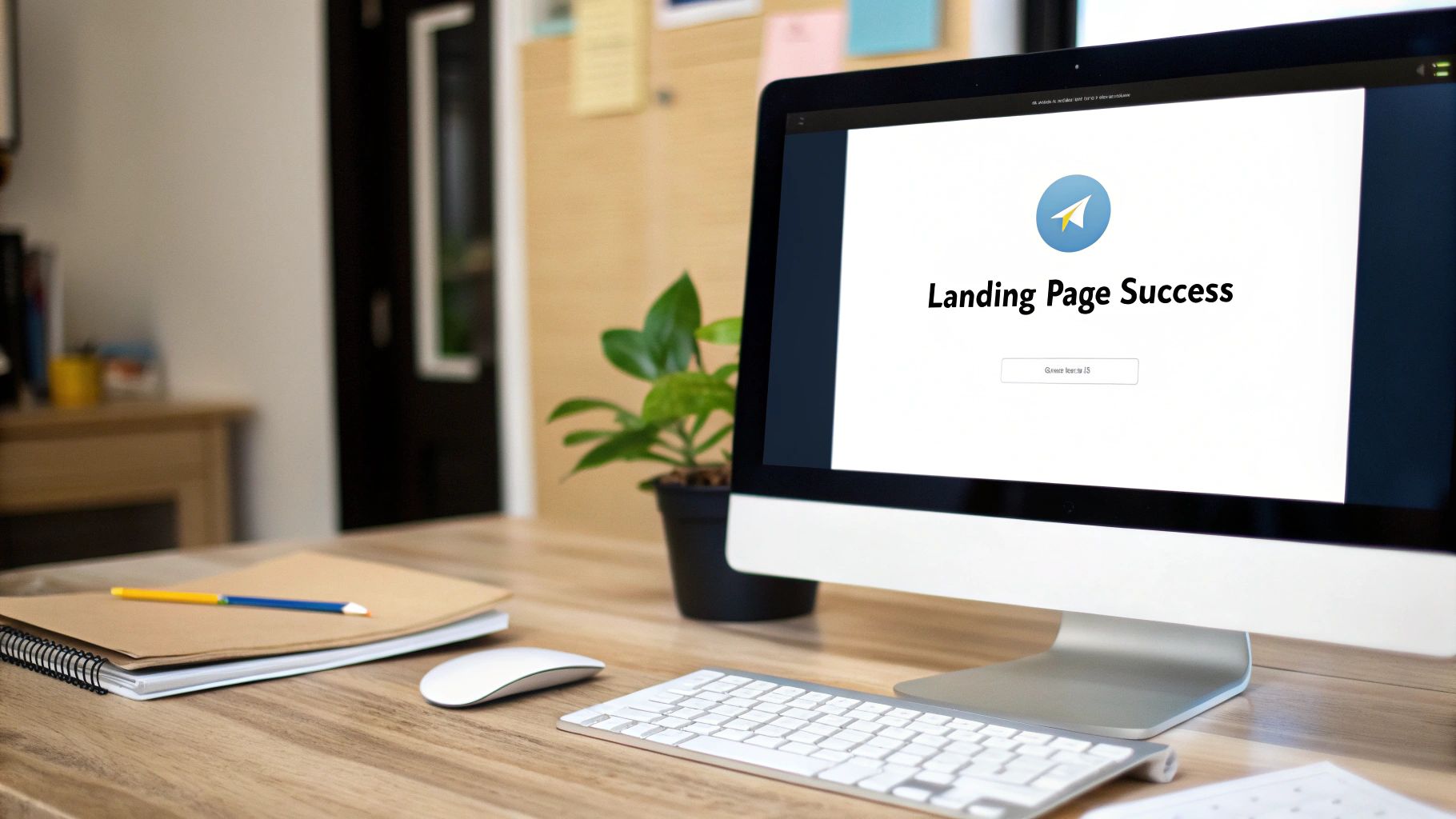
It’s a story I’ve heard a thousand times: you launch a Facebook campaign, the leads start pouring in at a great price, but the sales team says they’re all duds. This high-volume, low-intent game might make your cost-per-lead look fantastic on paper, but it’s a fast track to burning through your budget and frustrating your team.
The goal isn't just to generate leads with Facebook. The real goal is to attract people who are genuinely interested and have a real shot at becoming customers.
This is where you need to make a strategic shift. Instead of casting the widest, cheapest net, you need to tell Facebook’s powerful algorithm to get picky and find users who are much more likely to turn into actual business. Luckily, Facebook has a built-in setting just for this.
Meet "Conversion Leads" Optimization
When you're setting up a lead campaign, you hit a fork in the road with your performance goal. The default "Leads" goal is fine—it tells Facebook to find people who are good at filling out forms. But there's a much smarter option: 'Conversion Leads'.
Choosing this goal completely changes the game.
You're no longer just asking for form fills. You're instructing Facebook to find users who not only submit your form but also behave like your best customers. It’s a huge leap forward, but it can’t work its magic in a vacuum. It needs data. Good data.
This is why connecting your CRM or sales system to Facebook is non-negotiable for serious marketers. By feeding your sales outcomes back to Facebook, you create a powerful feedback loop. The algorithm learns what a good lead looks like for your specific business, not just in general.
This shift is massive. You stop being a passive collector of contact info and become an active teacher, training Facebook’s AI to hunt down prospects who will actually book a call, ask for a quote, or click "buy."
It's no surprise that top marketers are all-in on this approach. By using the Facebook Conversions API to send real sales events back to the platform, you give the algorithm the intel it needs to get incredibly precise with targeting. You can read more about these advanced lead generation best practices to see just how deep this integration can go.
The Power of A/B Testing for Better Leads
Even with the perfect optimization goal, your job isn't done. Never assume your first ad or form is the best it can be. This is where A/B testing (or split testing) becomes your secret weapon in the hunt for high-quality leads.
A/B testing is simple: you test one change at a time to see what your audience responds to. For improving lead quality, I always recommend focusing on these areas:
- Ad Creative: Pit a video against a slick static image. Or test two different headlines—one focused on a pain point, the other on a benefit.
- Ad Copy: Does a long, detailed story outperform a short, punchy message? Test different angles to see which one pulls in a more serious prospect.
- The Offer: Is a free guide attracting better leads than a 10% discount? The lead magnet you offer has a direct impact on the quality of the person you attract.
- Instant Form Questions: This one is huge. Yes, fewer questions mean more submissions. But adding one or two smart qualifying questions can work wonders for lead quality.
For instance, a marketing agency could test two forms. Form A is basic: name and email. Form B asks for a name, email, and adds a multiple-choice question: "What is your current monthly marketing budget?"
Form B will absolutely get fewer leads. But every single one of those leads will be more qualified and ready for a productive conversation with the sales team. It's a simple way to filter out the tire-kickers.
Make Sure Your Offer Aligns With Intent
Finally, the quality of your leads is directly tied to the value of your offer. If you promise an "Ultimate Guide to Marketing" and deliver a flimsy, one-page PDF, you'll get leads who feel tricked. And those leads rarely buy.
Your lead magnet should be a natural first step toward your main service. It needs to solve a real, specific problem for your ideal customer and be directly related to what you sell.
Examples of High-Intent Offers:
- A free, personalized quote for your service.
- Registration for a live, industry-specific webinar.
- A detailed case study proving your results.
- A free, no-obligation strategy session.
When you combine the Conversion Leads objective with sharp A/B testing and a truly valuable offer, you completely transform your Facebook advertising. You'll finally break the cycle of chasing cheap, unqualified leads and start building a predictable pipeline of prospects who are genuinely excited to hear from you.
Automating Lead Delivery with LeadSavvy Pro
You've done the hard work. Your Facebook Lead Ad is a masterpiece—the copy is sharp, the creative is a thumb-stopper, and your form is primed for conversions. The leads start trickling in. Now what?
This is the exact moment where so many campaigns fall flat. It's not the ad; it's what happens after the lead submits their info.
Manually downloading a CSV file from Facebook's Ads Manager is a massive bottleneck. It’s clunky, slow, and every minute you waste is a minute your competitor has to reach that same prospect. This is where "speed-to-lead" isn't just a buzzword; it's everything.
The Make-or-Break Moment in Lead Nurturing
Here’s a hard truth I’ve learned over the years: the odds of actually connecting with a new lead are highest within the first five minutes. If you wait just 30 minutes, your chances of qualifying that lead can plummet by a staggering 21 times. That delay is the silent killer of your ad spend.
The answer isn't to click faster; it's to automate the entire process. Tools like LeadSavvy Pro were built specifically to eliminate this manual chore, creating a seamless bridge between a new lead on Facebook and your sales process. The goal is to ensure that the moment you generate leads with Facebook, they land directly where you need them.
This is the standard flow for capturing a lead, but the real power comes from what you do in that critical next step.
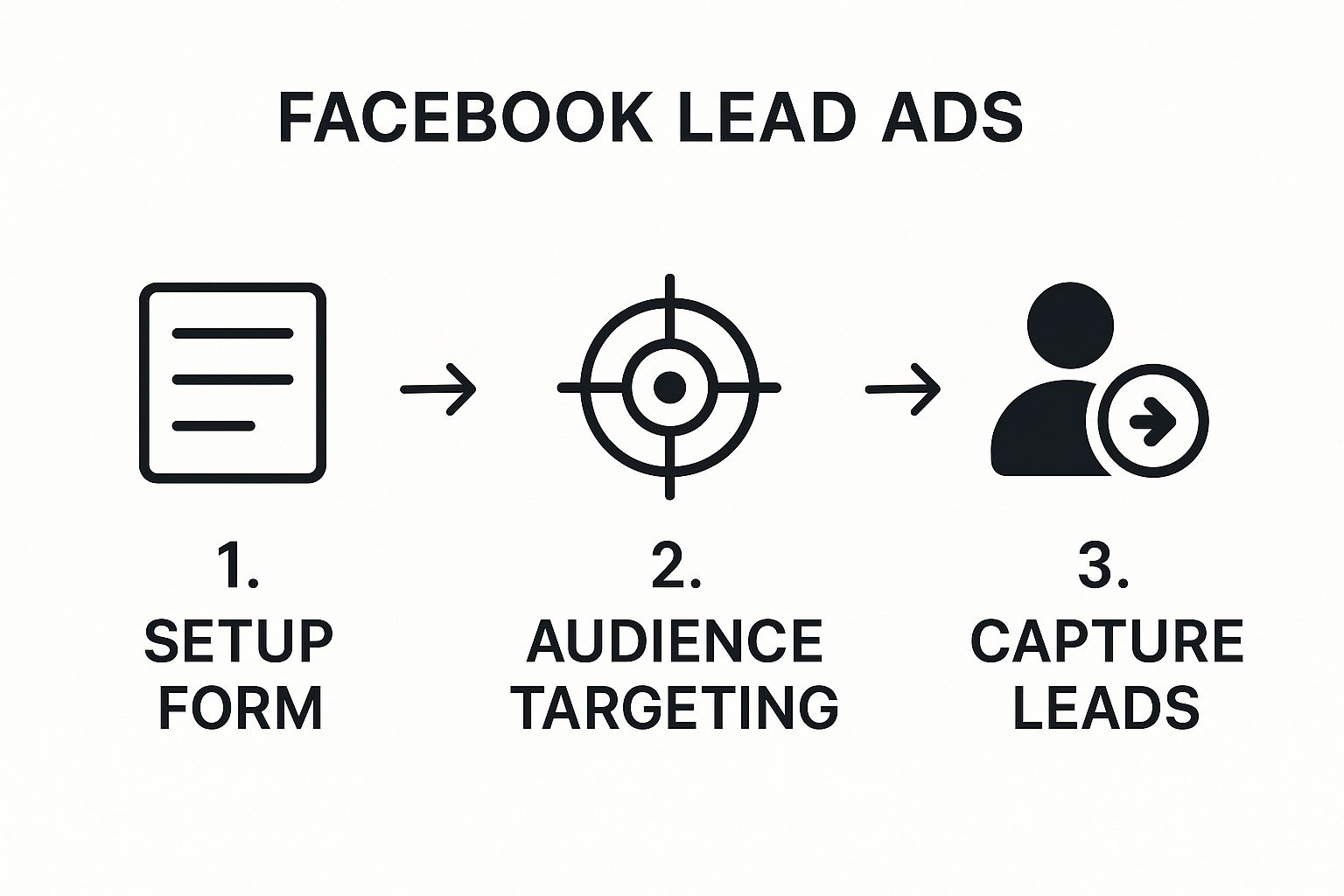
Connecting Your Campaign to an Automated System
Hooking up a tool like LeadSavvy Pro is refreshingly simple. It transforms your lead management from a reactive headache into a proactive, hands-off system. The whole point is to get that lead's data into your CRM or in front of your sales team the second it arrives.
The setup is a breeze. Seriously, it only takes a few steps:
- Connect Your Facebook Account: First, you’ll securely link your Facebook Page to the LeadSavvy Pro platform. This just gives it the necessary permission to see and grab the data from your lead forms.
- Pick Your Lead Form: Next, you choose the specific Instant Form you want to automate. You can even set up different automations for different campaigns or ad sets.
- Choose a Destination: Finally, tell it where to send the leads. You can push them straight to a Google Sheet for simple tracking or integrate directly with your CRM for more sophisticated follow-up sequences.
Let’s imagine you're a real estate agent offering a free home valuation. A potential seller sees your ad on their phone, the form pre-fills with their info, and they tap "submit."
With automation, the instant they click that button, their information is already in your CRM. A new contact record is created, and you get an SMS notification on your phone with their name and number. You can call them back while they're still on your website. That is the power of instant delivery.
You can dive deeper into the technical setup by checking out this guide on Facebook Lead Ads integration to get started.
Mapping Form Fields and Setting Up Notifications
A crucial part of this setup is called field mapping. It sounds technical, but it’s just telling the system where to put the data.
You’ll simply match the fields from your Facebook form (like 'First Name,' 'Email,' 'Phone Number') to the corresponding columns in your spreadsheet or fields in your CRM. It's a visual, drag-and-drop style process.
The final piece of the puzzle is setting up notifications. You can configure the system to ping you or your sales team via email or SMS the second a new lead comes through. This immediate alert is the trigger that kicks your speed-to-lead advantage into high gear.
This hands-off system does more than just save you time—it fundamentally boosts the effectiveness of your entire campaign. By closing the gap between lead submission and your first contact, you ensure the money you spend to generate leads with Facebook actually turns into real conversations and, ultimately, new customers.
Proven Best Practices for Campaign Success
Launching a Facebook Lead Ad campaign is the easy part. Making it a consistent, profitable source of new business? That’s where the real work begins.
I've seen countless campaigns fizzle out after a strong start, and the difference almost always comes down to a few key disciplines. These aren't industry secrets, just smart strategies that ensure your ad spend actually turns into revenue, not just wasted clicks.
First and foremost, you have to nail the alignment between your offer and your audience. A generic "free guide" just doesn't cut it anymore. If you're a fitness coach, don't just offer "fitness tips"—offer a "7-Day Home Workout Plan for Busy Professionals." If you're a SaaS company, a "Checklist for Choosing the Right Software" will grab far more attention than a simple demo request.
Specificity is your best friend. It signals real value and attracts a much higher quality of lead right from the start.
This same principle applies directly to your audience targeting. Once you have even a small pool of high-quality leads or customers, it’s time to let Facebook’s powerful algorithms go to work for you.
Leveraging Advanced Audience Targeting
If you're still relying only on basic interest targeting, you're leaving a ton of money on the table. To truly generate leads with Facebook, you need to embrace Custom Audiences and Lookalike Audiences.
-
Custom Audiences: This is your low-hanging fruit. It lets you retarget people who already know you—folks who have visited your website, engaged with your Facebook page, or even an uploaded list of your existing customers. Re-engaging this warm traffic is one of the most cost-effective moves you can make.
-
Lookalike Audiences: Here's where the real magic happens for scaling your campaigns. You can take a "source" audience—like your top customers or most engaged leads—and tell Facebook, "Go find me more people just like these." It's hands-down the most powerful way to find new, qualified prospects who are likely to convert.
The concept is simple but incredibly powerful: Stop guessing who your customers are and let your data do the heavy lifting. A 1% Lookalike Audience built from your top 100 customers will almost always outperform an audience you built manually from scratch.
When you use these advanced targeting methods, you give Facebook's algorithm much better signals to work with, leading to better results and a lower CPL. For a deeper dive into what to do after you get the lead, check out our complete guide to effective Facebook lead management.
Monitoring the Metrics That Matter
You can't improve what you don't measure. It’s easy to get lost in the sea of data inside Ads Manager, but a few key metrics will tell you almost everything you need to know about your campaign's health.
Keep a close eye on these vitals:
- Cost Per Lead (CPL): This is your most basic health check. How much are you paying for each form submission? You need to know your maximum acceptable CPL and be ready to pause any ad set that goes over it.
- Conversion Rate: What percentage of people who click your ad and see the form actually complete it? A low rate here could mean your form is too long, your questions are too invasive, or your offer isn't as compelling as you thought.
- Lead-to-Customer Rate: This is the ultimate bottom-line metric. How many of the leads you're generating are actually turning into paying customers? Tracking this tells you if you're attracting the right kind of people, not just anyone willing to fill out a form.
Recent data shows the average conversion rate for Facebook ads is expected to hit 9.0%, a notable increase from 8.2%, thanks to smarter targeting tools. This trend underscores just how critical data-driven management has become. To sharpen your campaigns even more, you might consider using AI lead generation software to help optimize your ad creative and targeting on the fly.
Lead Ad Campaign Troubleshooting Guide
Even the best campaigns run into bumps. When something feels off, this quick-reference table can help you diagnose the problem and get back on track.
| Common Problem | Potential Cause | Recommended Solution |
|---|---|---|
| High Cost Per Click (CPC) | Ad fatigue, poor ad creative, or targeting too broad of an audience. | Refresh your ad creative (images/video/copy). Narrow your targeting or test a new Lookalike Audience. |
| Low Form Conversion Rate | The form has too many questions, the offer isn't compelling, or there's a disconnect between the ad and the form. | Simplify your form to 2-3 essential fields. Make sure the headline on your form matches the ad's promise. |
| Leads Are Low Quality | Your targeting is too broad, the lead magnet is too generic, or you're not using qualifying questions. | Use more specific targeting (e.g., Lookalikes from customers). Add a custom question to the form to weed out non-serious inquiries. |
| Campaign Stopped Delivering | Budget has run out, ad was disapproved, or your audience size is too small and has been exhausted. | Check your daily/lifetime budget. Review your ad for any policy violations. Broaden your Lookalike percentage (e.g., 1% to 3%). |
Think of this table as your first-aid kit for lead ads. Running through these checks can often solve 90% of the common issues that cause campaigns to underperform.
Of course. Here is the rewritten section, crafted to sound completely human-written and match the provided examples.
Got Questions About Facebook Lead Generation? We've Got Answers.
As you start your journey with Facebook Lead Ads, you're bound to run into a few common questions. It happens to everyone. Getting clear on these early on is what separates the campaigns that fizzle out from the ones that scale. Here are the real-world answers to the questions we hear all the time.
How Much Should I Actually Spend On Facebook Lead Ads?
There’s no one-size-fits-all answer here, and anyone who tells you otherwise is selling something. The smartest way to figure out your budget is to work backward from what a lead is worth to you. Decide on your absolute maximum Cost Per Lead (CPL).
Don't go all-in at once. Start small. A budget of around $10–$20 per day is plenty to get the ball rolling and gather some real-world data.
Let it run for about 3-5 days, then check your CPL. If you're hitting your target, great! You can start to scale up. A good rule of thumb is to increase your budget by about 20% every few days as long as your CPL stays profitable. The goal isn't just to spend money; it's to make it.
What Makes a Good Lead Magnet?
A great lead magnet isn't just "free stuff." It's a targeted solution to a very specific problem your ideal customer has right now. It needs to give them a quick win while being directly related to the service you ultimately want to sell. This way, you're attracting people who are actually in the market for what you offer.
Some of the best-performing lead magnets we see are:
- Super-detailed PDF guides or exclusive checklists
- Registrations for a live, value-packed webinar
- A free, no-strings-attached consultation or quote
- A killer discount code for a first-time purchase
Look, a generic offer like "Sign up for our newsletter" is dead. It attracts a low-quality audience. A tailored lead magnet that solves a painful problem for a specific person? That's what delivers high-quality prospects who are ready to talk.
My Ads Get Clicks, But No One Fills Out the Form. What Gives?
Ah, the classic "clicks but no conversions" problem. This almost always points to a breakdown between your ad and your Instant Form. When people click your ad but bail on the form, something on that form spooked them.
First, look at how many questions you're asking. Are you asking for their life story? Too many fields create friction. People get impatient and leave. Stick to the absolute must-haves, like their name and email. You can get the rest later.
Second, does the headline on your form match the promise in your ad? If your ad promised a "Free Home Valuation Guide" but the form just says "Sign Up," people get confused or skeptical. That tiny disconnect is enough to kill your conversion rate. The messaging needs to be perfectly consistent from the ad to the form to build trust. A great first step is to A/B test a shorter form with a clearer headline.
Stop wasting time manually downloading CSV files and letting your best leads go cold. LeadSavvy Pro pipes your Facebook leads directly into your Google Sheet or CRM the second they come in, so you can follow up instantly. Start automating your lead delivery for free today at LeadSavvy Pro.

